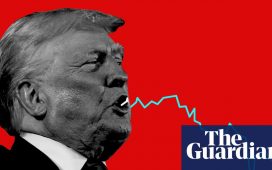Unlock the US Election Countdown newsletter for free
The stories that matter on money and politics in the race for the White House
Since picking up the baton from Joe Biden over four weeks ago, US vice-president Kamala Harris has performed surprisingly well against Donald Trump in presidential polling, boosting the Democratic party’s hopes for November’s elections. Her upbeat messaging has helped to consolidate support from the party’s base and has also wooed independent voters. But good vibes need to be matched by a solid policy platform. Ahead of this week’s Democratic National Convention, Harris unveiled snippets of her long-anticipated economic agenda in a speech in North Carolina on Friday. It proved disappointing, and tinged with excessive populism.
Harris outlined a series of measures designed to appease America’s cash-strapped middle classes, while blaming their woes on big business. The messaging may win over some households in swing states. The high cost of living is a core voter issue. The problem is that many of her proposals make for bad economics and risk alienating other parts of the electorate in the process.
Plans for a federal ban on “price gouging” on groceries — which have regrettably become her headline measure — are particularly misguided. Food prices have risen around 25 per cent since March 2020, faster than many workers’ wages. But Harris should note that state meddling in market pricing often makes matters worse. Economists also reckon high inflation in the post-pandemic period was driven more by supply-chain snags and labour shortages than by greed. Broader plans to root out any monopolistic practices by retailers are welcome, but price growth is still best tackled through monetary policy and measures to boost productivity.
The proposal — alongside the vice-president’s plans to raise the corporate tax rate from 21 per cent to 28 per cent to pay for her broader package — also risks turning away some voters. Business leaders, who may be flirting with Trump given his plans to cut corporate taxes, may be less inclined to vote for her. Indeed, the Republicans have already tapped into fears of a more interventionist Harris administration by dubbing her a “socialist”.
Not all of Harris’s policies are bad. Plans to raise tax credits for families with children and frontline workers are positive and will resonate with lower-income households. So will proposals to boost housing construction. The high cost of renting and home ownership has been a particular challenge for many Americans. But Harris has combined her plan with a proposed $25,000 in downpayment support for first-time buyers which, by stimulating demand, risks pushing up property prices before any new supply even arrives.
Harris needs to do more to complement her positive campaign with an inspiring vision for the US economy. Voters consider her to be an improvement on the ageing Biden, but she is still only narrowly more trusted to handle the economy than Trump — even though the former president’s plans to raise import tariffs and fiddle with Fed independence would do great damage.
A pro-growth agenda would help. Proposals to support innovation, infrastructure investment and small enterprises, which employ almost half of all Americans, would not only drive sustainable gains in living standards but would also curry favour with business leaders. The vice-president needs to provide more detail on her plans for trade and immigration, as well as how she intends to take Biden’s flagship Inflation Reduction Act forward. Harris may have energised the Democratic party’s campaign, but she needs to think bigger than economic gimmicks.









